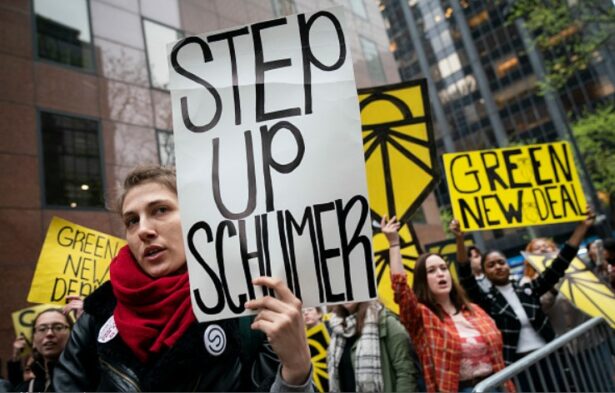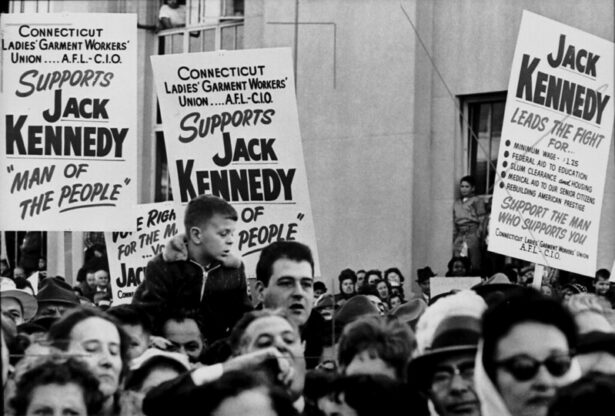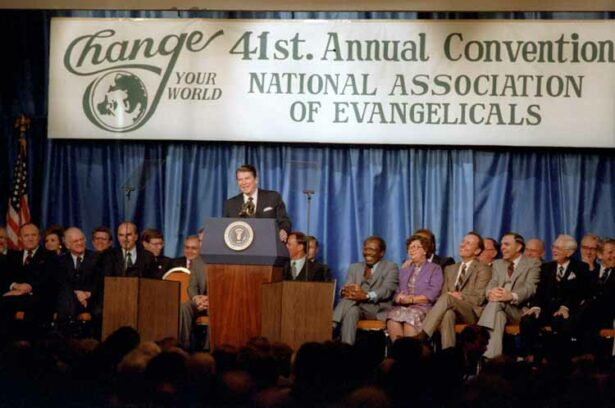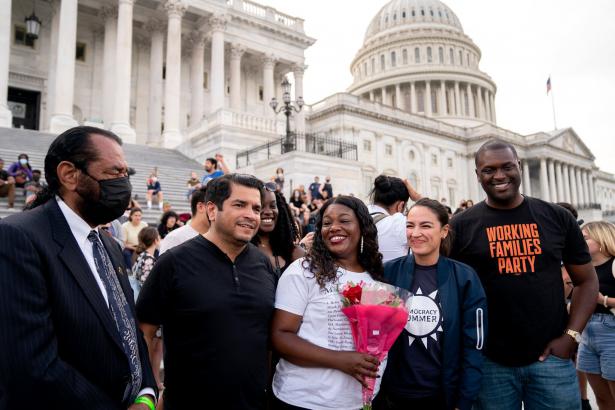When trying to figure out how they should interact with political parties, social movements face a common challenge: Should they push from without or seek to operate from within? Should they act as a destabilizing threat to all politicians, or should they work to build strength within a mainstream party?
Frances Fox Piven and Daniel Schlozman are two theorists who stand at opposite poles of this debate. In Piven’s view, movements win by deploying disruptive power from the outside that can polarize the public and create discomfort among politicians. “ovements of mass defiance fired the most important episodes of class and racial reform in the 20th century,” she contends. “This capacity to create political crises through disrupting institutions is … the chief resource for political influence possessed by the poorer classes.”
Schlozman, on the other hand, upholds the view that movements wanting to wield power in the United States do best when they move toward the inside and embed themselves within a traditional political party — and he warns that failure to do so can reduce once-promising mobilizations into historical footnotes. “Movements for fundamental change in American society seek influence through alliance, by serving as anchoring groups to sympathetic parties,” he argues, “because parties hold the special capacity to control the government and its resources, and to define the organizable alternatives in public life.” Movements that limit themselves to outside agitation, he believes, lose much as a result.
PREVIOUS COVERAGE

Can social movements realign America’s political parties to win big change?
This debate is one with genuine consequences. At present, climate justice organizers, Black Lives Matter activists, and a resurgent socialist movement are all debating how they should engage with mainstream parties — and how they can most effectively extract concessions from the Biden administration. Even as mass protests have risen up, community organizations long averse to electoral politics are throwing down to elect champions to local office. Criminal justice reform advocates have propelled a new wave of progressive district attorneys to office. Meanwhile, groups like Justice Democrats are working to expand the Squad in Congress and, in the process, create a faction powerful enough to realign the politics of the Democratic Party.
As they pursue such diverse efforts to build power, activists must make some tough decisions. One of them is choosing what side they will take in the debate between Piven and Schlozman. While some movements have tried to split the difference by combining electoral work with outsider organizing, there are unavoidable tensions between the two approaches, and these frequently generate conflict between organizations taking different paths. How groups manage these tensions will have a profound impact in determining how effective they can be in creating change.
“Disruptive dissensus” and the power of outside agitation
Now in her late 80s, Frances Fox Piven long held the post of Distinguished Professor of Political Science and Sociology at the City University of New York Graduate Center. In her landmark 1977 book, “Poor People’s Movements,” written with her late husband and longtime collaborator Richard Cloward, she made the case that movements of the disenfranchised have the most impact when they defy well-meaning advisors who tell them to work through the accepted channels of mainstream politics and instead become unruly. Historically, Piven argues, such groups have gained leverage by harnessing the power of disruption and deploying such tactics as “militant boycotts, sit-ins, traffic tie-ups, and rent strikes.” These cause “commotion among bureaucrats, excitement in the media, dismay among influential segments of the community and strain for political leaders.”
“When [marginalized groups] just quietly follow along and support political leaders, they’re ignored … It’s only when they make trouble that they are attended to.”
Piven’s theory of “dissensus politics” holds that movements make gains by threatening to pull apart the majorities that elected officials have cobbled together. “Politicians don’t like divisions,” she said, “They especially don’t like divisions within their coalition. To fend off the splintering of their coalition, they will try to propose reform. And that’s how movements win.”
“We have to start by realizing that the dynamics of electoral politics and movement politics are very different,” Piven explained. “In particular, the sort of logic of winning in electoral politics is different from the logic of winning in movement politics. If you have a two-party system, and you want to win elections, you need a majority. And to create a majority, you have to build coalitions and alliances between different groups. The magic of the electoral politician is the ability to bring these groups together by finding the issues, the rhetoric, and the mood that will unite them.” Social movements, on the other hand, rely on “division and polarization,” she argues: “In movements, agitators identify issues and raise hell over them. They drive groups into action — and some groups they will drive away.”
For people lacking wealth and insider status, such cleavages are a source of power. “When [marginalized groups] just quietly follow along and support political leaders, they’re ignored,” Piven states. “That’s the way it’s always been. It’s only when they make trouble that they are attended to. It’s only in the aftermath of trouble that you can have some dialogue.”
Elaborating on this point, Piven and Cloward wrote in 1999, “Although a small poor people’s lobby can be ignored with impunity by political leaders, institutional breakdowns that contribute to discontent among large and variegated segments of the cannot be.” Movements that exacerbate such crises play a unique role in shaping political consciousness. As Piven and Cloward write, “Disruptive protests have communicative power, the capacity — through the drama of defiant actions and the conflicts they provoke — to project a vision of the world different from that in ruling-class propaganda, and to politicize millions of voters.”
PREVIOUS COVERAGE

This politicizing function is especially critical in the United States. “For reasons that are deeply rooted in our history and governmental structures (not least mass disenfranchisement of the poorer classes by voter registration procedures during most of the 20th century), the political parties in the United States are not sharply class-based,” Piven and Cloward argue. Absent the kind of labor party that we might typically see in Europe, “it is difficult for people to define their interests in a way that is consistent with their class position. Thus movements generate the conflicts that politicize voters, and that makes votes count.” It is when social movement groups politicize the electorate that politicians must scramble to respond. Or, as Piven and Cloward put it, “To avoid worsening polarization and to restore institutional stability, political leaders must either promulgate concessions or institute repression.”
This dynamic does not usually lead to harmonious relations between movements and politicians. Instead, the fact that the two have different sources of power inevitably leads to tensions. “As an elected politician, coalitions are sort of your meat and potatoes,” Piven said. “And if activists have the effect of straining those coalitions, then it’s difficult to treat these people as allies. But they are allies if you’re interested in addressing injustices.”
“There are all sorts of things that have to be done in electoral politics, but movements have a distinctive contribution to make in order to create substantial democracy.”
Piven also acknowledges that sometimes polarizing actions by social movements can hurt the Democrats. “Not everything a movement does supports the broad agenda of reform,” she said. “It’s true some disruption drives some people away.” Nevertheless, she sees polarization as an essential element in propelling reform. “In a memorable saying, [famed community organizer Saul] Alinsky admonished organizers to ‘Rub raw the sores of discontent,’” Piven and Cloward wrote. “We add, ‘Rub raw the sores of dissensus.’ It is then that political leaders will attempt to stabilize a new realignment … and concessions to the bottom may become possible.”
In short, Piven argues that the unique role of movements is to raise hell on the outside, not to focus on the internal maneuvering of factions within mainstream political parties. “I think that’s for somebody else to do,” explains Piven. “Movement organizers who are trying to build power among low-income people and racial minorities don’t have to work on that. There needs to be a division of labor. There are all sorts of things that have to be done in electoral politics, but movements have a distinctive contribution to make in order to create substantial democracy.”
The decision to anchor a party
While also writing from a left-of-center perspective, Johns Hopkins political scientist Daniel Scholzman takes a decidedly different position on how movements can best propel change. Unlike Piven, who entered academia by a circuitous route after previously working with anti-poverty groups in New York City, Scholzman pursued a more conventional path, volunteering in the Cambridge office of the Democratic Party while working on his PhD in government and social policy at Harvard. Nevertheless, he has taken a keen interest in social movements, and his 2015 book, “When Movements Anchor Parties: Electoral Alignments in American History,” has been of significant interest within Justice Democrats and among other activists seeking to vie for power within the Democratic Party.
For Schlozman, political parties have a unique and unavoidable role in the political system, one that is too often underappreciated by outside agitators. In his book, he quotes mid-century political scientist E.E. Schattschneider, who argued, “A political party is an organized attempt to get control of the government.” In other countries, movements that differ ideologically from major political parties simply break off and form their own. However, the entrenched two-party system in the United States inhibits such action with ballot access restrictions, first-past-the-post voting, and a lack of proportional representation. Instead, it compels movements to either align with the Democrats or Republicans, or to give up on a key route to power. “We have a political system that is stacked against big change,” Schlozman said. “And in this system, conflict largely takes place inside parties.” If movements want to share in the control over government that parties offer, he believes, they must become full participants in this internal battle.

Connecticut ILGWU members rally supporting John F. Kennedy for U.S. president, 1959. (Flickr/Kheel Center)
Schlozman’s book proposes that the movements which are most successful at executing this gambit become “anchor” groups in electoral politics by mobilizing a reliable base of support for a chosen political party over an extended period. Schlozman pays particular attention to how organized labor secured lasting influence within the Democratic establishment starting during the New Deal, and how the religious right became an anchor within the Republicans in the Reagan era. “Inside parties, anchoring groups exercise broad influence on national politics by virtue of the money, votes and networks that they offer to the party with which they have allied,” he explained. In exchange for loyalty, anchoring movements gain the ability to shape parties’ long-term trajectories and influence their ideological character.
As opposed to standard pressure groups, who will push their issue on both sides of the aisle, anchors exhibit loyalty to a single party on an extended basis. “How did we get to the world where the Supreme Court threatens basically to overturn Roe v. Wade?” Schlozman asked. “Answer: a party-wide project that has played out over a long, long time. This was not just the Christian Right treating abortion as one issue among many, where they were going to lobby legislators. By becoming an anchor and entering the Republicans, they shaped the whole worldview of the party around their priorities.”
In contrast, movements that fail to become anchors face serious consequences. Schlozman points to the populists of the 1890s and the antiwar movement of the 1960s as political formations whose legacies were severely diminished by their inability to enter a major party. “With Populism died the most serious challenge to corporate capitalism that the United States would ever see,” he writes. And “although its personnel occupied positions at the top of the Democratic Party for decades, the antiwar movement failed to restrain American empire.”
The decision to try to anchor a political party, however, is not one that movements can take lightly. As a cost of entering into an alliance with a mainstream group, movement leaders may have to distance themselves from radicals in their ranks who pursue precisely the type of disruptive protest that Piven recommends. “We see the price mostly clearly with the labor movement in the late 1940s,” Schlozman explained. “As the Cold War escalates, they have to push out the Communist unions that contain their most dedicated organizers. As for the Christian Right, they had to accept that they’re not building a Christian America; they had to accept that, within the party of Ronald Reagan, they would still play second fiddle to economic conservatives for a long time. Those are heavy prices.”

President Reagan addressing the Annual Convention of the National Association of Evangelicals in 1983. (Flickr/Levan Ramishvilli)
And yet, Schlozman believes that “given the rules of the game, is a price well worth paying.” Those movements unable to exert influence from inside a party risk being ignored completely. “One benefit of durable, long-term alliance is that you don’t get abandoned the minute your movement is no longer in the spotlight,” he explained. “The Christian Right has secured long-term benefits, even as its demographic share in the population stopped rising and as public religiosity declined. But in exchange for a durable alliance, you give up your freedom to say exactly what you want, when you want — because you have to protect your allies.”
Schlozman recognizes that many activists will reject the uncomfortable bargain inherent in such alliances. “Maximalists who prize movement autonomy and confrontational tactics may … to continue to agitate from the outside,” he writes. But he believes that this decision is incredibly risky: “No social movement has sustained effective militancy on a society wide basis … over decades. Passions fade; radicals and moderates split; organizations collapse.”
Scholzman’s disagreement with Piven’s theory of “disruptive dissensus” largely comes down to a debate about timeframe. “For a theorist like Piven, everything happens at of crisis,” he said. “But if you understand politics as something that happens over a series of decades, then you can’t really understand the ongoing influence of social movements unless you think of them all the way through this long lifecycle. You have to look at how movements can continue to exert influence. You have to look at how that influence is dependent on their mass base, but is often done through ‘regularized’ means of electoral work and lobbying, even during lulls in protest.”
Although Schlozman acknowledges that periods of intensive uprising can put movements on the map, he argues, in the tradition of a famous essay by Bayard Rustin, that activists must move “From Protest to Politics” if they want to be effective in the long run.
Weighing the debate
Needless to say, Piven and Schlozman represent stances that are far apart, and their respective followers would pursue very different courses of action. What lessons, then, can activists draw from their debate?
First, although juxtaposing the two perspectives reveals incontrovertible differences, it is worth noting that both theorists acknowledge that militant protests and long-term organizing can each have a role at select times. Schlozman notes that confrontational protest can be critical in helping movements to break into public consciousness and to create the types of networks that make parties welcome them in the first place. “There is a role for militancy, and there are certain moments when movements need to strike when the iron is hot,” he admitted.
For her part, Piven affirms that in times of retrenchment, when the prospect of widespread defiance seems distant, more conventional organizing and political work is warranted. “During quiescent periods,” she and Cloward write, “it is reasonable for organizers to emphasize organization-building.” Substantial portions of Piven’s career have been devoted to projects other than raucous protest. For years, she and Cloward were involved in advocacy to build up voting blocs favorable to progressive politics, founding an organization called Human SERVE (Human Service Employees Registration and Voters Education) to advance voter registration in low-income communities. Their work was critical in securing passage of the National Voter Registration Act of 1993, commonly referred to as the “Motor Voter Bill.” This law makes voter registration available at social services agencies that provide unemployment, welfare, and disability benefits — as well as at places where people renew their drivers’ licenses.
“People don’t join movements unless they think they can win something. What makes them think that they can win is often the electoral environment and the promises that politicians make.”
“The reason we undertook this rather conventional electoral reform project,” Piven and Cloward explained in 1999, “is that the success of disruptive protest depends … on the ability of the protesters to galvanize and polarize electoral blocs, to fragment or threaten to fragment electoral coalitions. But protesters obviously need supportive voter blocs if this process of dissensus is to benefit them. This means, for one thing, that the social base from which protesters are drawn must be fully able to vote.”
Piven has long argued that movement and electoral approaches are not exclusive. “People don’t join movements unless they think they can win something,” she said. “What makes them think that they can win is often the electoral environment and the promises that politicians make. When politicians are trying to win an election, they blast off about what they’re going to do differently, and they create a good deal of hope. By doing that, they help to instigate the kind of hopefulness and ambition that fuels movement politics.”
Later, according to the dissensus model, movement constituencies can extract concessions by being disruptive and threatening to fracture electoral coalitions. But obviously there are limits to this approach. If disruptive movements pull apart the blocs that sympathetic politicians assembled to get elected, it can allow most hostile rivals to take advantage. Along these lines, civil rights activists succeeded in expelling Southern Dixiecrats from the Democratic Party, but the defection was a boon for Republicans.
While Piven offers the warning that being quiet and loyal can be a recipe for being taken for granted, Schlozman cautions that boisterous action can also have down sides. Movements can overplay their hand if they do not control large enough constituencies. “In a vast country like the United States, change is really hard, and no small element is going to be a majority,” Schlozman argued. “If you start off with those elemental facts about American politics, then paying the price of alliance suddenly looks a lot more worth it than it might look if you’re just focused on immediate tactics.”
Influence outside anchoring
A second point to consider in weighing the debate between Piven and Schlozman is whether anchoring is the only option available to social movements seeking to achieve influence — or whether there might be multiple ways for activists to pressure political parties from both inside and out, while never embracing a complete marriage.
PREVIOUS COVERAGE

Schlozman makes a compelling case that institutionalizing by embedding within a political party can lead to victories. And yet many of the major movements of the past century do not fit within his “anchoring” typology, but they nevertheless possess significant legacies. The movement for LGBTQ rights, and its landmark victory on the issue of same-sex marriage, serves as an important case in point. This is not a movement Schlozman identifies as an anchor group, and still the gains it has achieved arguably rival those of the labor movement or the religious right, which have burrowed within the major parties.
Schlozman explains victories by LGBTQ communities as examples of what he calls “cultural persuasion.” As he states, “I think that the LGBTQ movement is a good example of when culture is upstream from politics. … If you have a group that is treated unsympathetically, which you want to be treated more sympathetically, figuring out how to do this kind of persuasion is smart.” By reframing values and ideas, Schlozman explains, movements can persuade through cultural means rather than directly political ones. “I’m not sure I would have advised that movement correctly,” he admitted. “But I think they got that right.”
While Schlozman believes that such persuasion only works with a select few issues, those in the Pivenite camp would see a large part of social movement activity as being “upstream” of formal politics. And they would argue that the boundaries between what are cultural issues and what are political ones is constantly being redefined. “The urgency, solidarity and militancy that conflict generates lends movements distinctive capacities as political communicators” Piven writes. “Where politicians seek to narrow the parameters of political discussion, of the range of issues that are properly considered political problems and of the sorts of remedies available, movements can expand the political universe by bringing entirely new issues to the fore and by forcing new remedies into consideration.” In other words, movements change the political landscape within which elected officials operate.
The antiwar movement of the 1960s provides an intriguing example. Here, Schlozman sees an effort that fell short: “The antiwar movement did not just want to end the invasion of Vietnam, it wanted to roll back the worst parts of American imperialism,” he said. “As they aged, members of that movement became part of the new Democratic establishment, but there’s no actual organized movement that they brought with them. So there’s no real, ongoing dovish presence to push against American empire. It’s just not there. Instead, many of these politicians who might have identified as young activists in the ’60s become the liberal hawks of the 1990s and 2000s.”
PREVIOUS COVERAGE

Certainly, it is legitimate to criticize such shortcomings. But they are not the whole story. Beyond helping to end the Vietnam War and eliminating the military draft in the United States, there is good argument that the movement had a lingering effect in constraining overt militarism for a significant period. Scholars such as Stephen Zunes have taken the position that the prospect of mass protest and public revolt “served as a deterrent for large-scale U.S. military interventions overseas for the next three decades, a phenomenon known by detractors as ‘the Vietnam Syndrome.’” Notably, the likelihood of public backlash made it politically impossible for the Reagan administration to directly deploy U.S. troops in Central America during the death squad wars of the 1980s — something that many administration officials would otherwise have been eager to do.
The antiwar movement did not win everything it wanted, but what political formation ever does? Despite anchoring within the Democratic Party, the labor movement has dwindled to a fraction of its size of a half-century ago, and it has perennially failed to get serious labor law reform enacted. Ultimately, efforts as varied as second-wave feminism, environmentalism and the civil rights movement do not become anchor groups by Schlozman’s definition, but have had major impacts. Each movement has institutionalized over the decades through a combination of means — winning some legal gains and some political ones; some advances in culture and others within business, religious, and other non-state institutions. Put together, the changes they have wrought show that even movements that do not embed within a political party can have lasting importance.
From Piven’s perspective, the fact that long-term gains are never guaranteed is reason to maximize the impact of disruptive moments when they occur: “Turbulence will not last,” she and Cloward advise: “Get people what you can, while you can.”
An ecological view
As much as organizers might wish for strategic unity, in the end movements are diverse and messy formations, involving both inside and outside politics. Bayard Rustin’s proposal that movements transition from “Protest to Politics” proposes a linear progression for organizers to follow, but an alternate way of looking at movements would use an ecological perspective. At any given time, a movement will contain groups and individuals devoted to different strategies and organizing models: In addition to the advocates of disobedience that Piven champions and the inside-game players that Schlozman highlights, there will be base-builders who focus on building unions, community organizations, and other structure-based groups, and there will be counter-cultural groups focused on keeping radical ideas alive by carving out alternative spaces and dissident communities. Each of these approaches has important contributions to make, and all of these tendencies together help to form an ecosystem that promotes change.
Although organizers must decide where their own organizations stand in the debate between anchoring and disruption, they must accept that not all groups will make the same decision. Therefore, they need to figure out methods for collaborating and coexisting with those who have different strategies. Even as they sometimes butt heads with people in these groups, they must determine how to act in ways that allow the ecosystem as a whole to thrive.
To the extent that there is a progression between them, we can look at how different elements of the ecology come to the fore at various moments in the life cycle of a cause, only to recede at other junctures — and how some might re-emerge to once again play a significant role later, defying a clean and linear succession. Watching a whole movement ecosystem develop over time might reveal, for example, that groups without skill in mass protest will sorely miss that capacity in peak moments of social tension, and that those accustomed to always striking an outsider pose may leave worthwhile gains on the table if they lack insider allies in times when the establishment is ready to grant concessions.
Schlozman, for his part, acknowledges that “Movements always have their radicals and their moderates. And they may need both. But that doesn’t say exactly how radical the radicals should be, and how moderate the moderates should be — and whether or not they can actually work together.” Expanding on this point, he offers a word of caution: “I would say that people in movements should be aware of where they are in that spectrum and figure out how to support one another, and not eat each other alive. Because when they can’t work together, that’s really bad.”
Both Piven and Schlozman see social movements as being critical forces in shaping American democracy, having an influence on formal institutions that most political scientists fail to appreciate. This influence comes not from a single protest group or coalition moving in strategic lockstep. Rather, it comes from a sometimes chaotic amalgam of grassroots groups operating with diverse backgrounds and ideologies, whose combined efforts result in sometimes unpredictable transformations. Taking an ecological view does not exempt organizers from strategic decision-making, nor from taking seriously the dilemma of whether disrupting political parties or anchoring them represents a more fruitful goal. But it does suggest that how they interact with others who make different choices will be as important as the path they choose themselves.
Research assistance provided by Celeste Pepitone-Nahas.
Mark Engler is a writer based in Philadelphia, an editorial board member at Dissent, and co-author of "This Is An Uprising: How Nonviolent Revolt Is Shaping the Twenty-first Century" (Nation Books). He can be reached via the website www.DemocracyUprising.com.
Paul Engler is the director of the Center for the Working Poor in Los Angeles, and a co-founder of the Momentum Training, and co-author, with Mark Engler, of "This Is An Uprising."
Waging Nonviolence is a nonprofit media organization dedicated to providing original reporting and expert analysis of social movements around the world. With a commitment to accuracy, transparency and editorial independence, we examine today’s most crucial issues by shining a light on those who are organizing for just and peaceful solutions.
Waging Nonviolence is only able to produce unique, in-depth movement news and analysis with your financial support. Monthly donations help us plan for the future and develop strong relationships with the talented journalists and activists who write for us. Please make a tax-deductible donation today! We accept credit card, Paypal and direct bank payments.


Spread the word